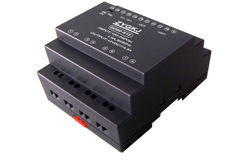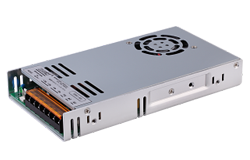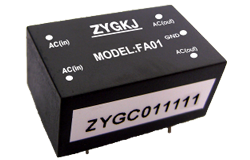news
Converting 12V AC to DC for LED manufacture: An Efficient Solution
Author: ZYG Power Module Time: 2023-7-31
Introduction:
LEDs (Light Emitting Diodes) have become increasingly popular due to their energy efficiency and durability. However, one challenge in utilizing LEDs is the need to convert the alternating current (AC) power source to direct current (DC) for their operation. In this article, we will explore an efficient solution for converting 12V AC to DC for LED applications, highlighting its benefits and implementation.
Understanding the Need for Conversion:
While LEDs are designed to operate on low voltage DC power, the main power supply in most households and commercial buildings is AC power. Therefore, it is necessary to convert the incoming AC power to DC in order to power LEDs efficiently and effectively. This conversion process involves eliminating the negative half-cycles of the AC waveform and converting it to a continuous flow of current with a constant polarity.
The Challenges of Converting 12V AC to DC:
Converting 12V AC to DC presents unique challenges that must be addressed. One primary concern is the voltage drop that occurs during the conversion process. Since LEDs require a specific voltage to operate optimally, any significant voltage drop can lead to reduced brightness and performance. Additionally, the conversion process must be efficient to minimize energy loss and ensure the longevity of the LED.
An Efficient Solution: The Bridge Rectifier Circuit:
One widely used solution for converting 12V AC to DC for LED applications is the bridge rectifier circuit. This circuit consists of four diodes arranged in a bridge configuration, allowing it to convert the AC voltage to DC effectively. The bridge rectifier circuit is highly efficient, as it utilizes all parts of the AC waveform and eliminates the need for additional components like transformers.
Implementation of the Bridge Rectifier Circuit:
To implement the bridge rectifier circuit for converting 12V AC to DC, the following steps can be followed:
1. Identify the input voltage: Determine the voltage of the AC power source, ensuring it is within the acceptable range for the bridge rectifier circuit.
2. Select appropriate diodes: Choose four diodes capable of handling the input voltage and current. It is important to consider their forward voltage drop and reverse leakage current specifications.
3. Connect the diodes: Connect the diodes in a bridge configuration, ensuring the correct polarity. This configuration allows the diodes to conduct current in alternating directions during each half-cycle of the AC waveform.
4. Connect the load: Connect the LED load to the output of the bridge rectifier circuit. It is crucial to ensure the polarity is correct to prevent damage to the LEDs.

Benefits of Using the Bridge Rectifier Circuit:
The bridge rectifier circuit offers several advantages for converting 12V AC to DC for LED applications:
1. High efficiency: The bridge rectifier circuit efficiently converts AC power to DC power, minimizing energy loss during the conversion process.
2. Cost-effective: The bridge rectifier circuit eliminates the need for additional components like transformers, making it a cost-effective solution.
3. Compact size: The bridge rectifier circuit is relatively small in size, allowing for easy integration into LED lighting fixtures and other applications.
Conclusion:
Converting 12V AC to DC for LED applications is a crucial step in utilizing LEDs effectively. The bridge rectifier circuit provides an efficient and cost-effective solution for this conversion process. By understanding the challenges involved and implementing the bridge rectifier circuit correctly, LED users can ensure optimal performance and longevity of their lighting systems.
Previous: China SP Series wholesale : An AC DC Converter for Efficient Power Conversion
Next: Cheap SP Series wholesale: The Ultimate AC DC Converter Solution
relevant information
-
2023-12-19
With the rapid advancement of technology, electronic devices have become an inseparable part of our daily lives. From smartphones to laptops, these gadgets have revolutionized the way we communicate, work, and entertain ourselves. However, one common challenge that every electronic device faces is the need for a reliable and efficient power supply. To address this issue, the DC to DC step-down adjustable power supply module has emerged as a game-changer in the field of voltage regulation. This module offers a wide range of benefits, including increased efficiency, voltage stability, and versatility. One of the primary advantages of using a DC to DC step-down adjustable power supply module is its ability to efficiently convert higher voltages into lower ones. This is...
View details -
2023-10-19
High Voltage Power Supply Module: Unleashing Power for Enhanced Performance
Introduction High voltage power supply modules play a crucial role in various industries such as manufacturing, medical, research, and telecommunications. These modules are responsible for providing power to devices and equipment that require high voltages, ensuring their optimal performance. This article will explore the significance of high voltage power supply modules and how they contribute to enhancing performance in different applications. Importance of High Voltage Power Supply Modules High voltage power supply modules are designed to convert low voltage input into high voltage output, typically in the range of kilovolts (kV) or even megavolts (MV). This high voltage output is essential for several applications that demand powerful electrical energy. These modules are utilized in a wide range of industries and...
View details -
2023-11-23
Empowering Electronics: The Crucial Role of AC DC 5V Power Supply Modules in Modern Devices
In today's modern world, electronic devices have become an integral part of our lives. From smartphones to laptops, we heavily rely on these gadgets for communication, entertainment, and work. However, the smooth and efficient operation of these devices is only possible with a continuous and stable supply of power. This is where the AC DC 5V Power Supply Module comes into play. In this article, we will delve into the intricacies of this module and understand its significance in powering various electronic devices. Understanding the AC DC 5V Power Supply Module The AC DC 5V Power Supply Module is an essential component that converts the alternating current (AC) from the main power supply into direct current (DC) with a stable...
View details -
2023-8-9
Efficient AC to DC Converter manufacture: Powering LED Lights with a 12V Output
In recent years, LED lights have gained popularity due to their energy efficiency, long lifespan, and versatile applications. However, to power these lights, an efficient AC to DC converter is required. In this article, we will explore the importance of such a converter and how it enables us to power LED lights with a 12V output. An AC to DC converter, also known as a rectifier, is an electrical device that converts alternating current (AC) into direct current (DC). This conversion is necessary because most electronic devices, including LED lights, require DC power to function. AC power, which is supplied by the electrical grid, constantly changes direction, whereas DC power flows in a single direction. LED lights, unlike traditional incandescent...
View details -
2023-4-25
Building a 120V AC Power Supply for 3V DC Output
Introduction In this project, we will be designing a 120V AC power supply that will convert the high voltage AC input to a low voltage DC output of 3V. The power supply will be used to power small electronic devices that require a low voltage DC supply. Design The first step in designing the power supply is to select the components required for the circuit. We will be using a step-down transformer to reduce the high voltage AC input to a low voltage AC output. The AC output will then be rectified using diodes, and the resulting DC voltage will be filtered using capacitors to remove any residual AC ripple. Finally, the regulated DC voltage will be produced using a...
View details -
2023-5-24
Efficient 24V AC to DC Converter for Smooth Power Conversion
In today's world, power conversion is a critical aspect of modern technology. A significant amount of electronic equipment requires a stable and regulated power supply to function correctly. One of the most commonly used power conversion methods is the AC to DC converter. An AC to DC converter performs the essential task of converting alternating current (AC) to direct current (DC). In this article, we will be discussing the efficient 24V AC to DC converter for smooth power conversion. The primary objective of this converter is to convert AC power to DC power with minimal losses and provide a constant DC voltage output. The 24V AC to DC converter is widely used in various electronic applications, such as in computers,...
View details


















